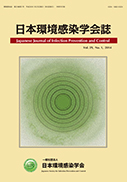Volume 24, Issue 5
Displaying 1-10 of 10 articles from this issue
- |<
- <
- 1
- >
- >|
Original Articles
-
2009Volume 24Issue 5 Pages 303-311
Published: 2009
Released on J-STAGE: December 10, 2009
Download PDF (658K) -
2009Volume 24Issue 5 Pages 312-318
Published: 2009
Released on J-STAGE: December 10, 2009
Download PDF (631K) -
2009Volume 24Issue 5 Pages 319-324
Published: 2009
Released on J-STAGE: December 10, 2009
Download PDF (436K) -
2009Volume 24Issue 5 Pages 325-331
Published: 2009
Released on J-STAGE: December 10, 2009
Download PDF (463K)
Short Paper
-
2009Volume 24Issue 5 Pages 332-336
Published: 2009
Released on J-STAGE: December 10, 2009
Download PDF (387K)
Reports
-
2009Volume 24Issue 5 Pages 337-341
Published: 2009
Released on J-STAGE: December 10, 2009
Download PDF (645K) -
2009Volume 24Issue 5 Pages 342-346
Published: 2009
Released on J-STAGE: December 10, 2009
Download PDF (540K) -
2009Volume 24Issue 5 Pages 347-352
Published: 2009
Released on J-STAGE: December 10, 2009
Download PDF (755K) -
2009Volume 24Issue 5 Pages 353-357
Published: 2009
Released on J-STAGE: December 10, 2009
Download PDF (389K) -
2009Volume 24Issue 5 Pages 358-364
Published: 2009
Released on J-STAGE: December 10, 2009
Download PDF (760K)
- |<
- <
- 1
- >
- >|
